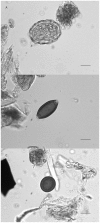Intestinal parasites in First World War German soldiers from "Kilianstollen", Carspach, France
- PMID: 25333988
- PMCID: PMC4198135
- DOI: 10.1371/journal.pone.0109543
Intestinal parasites in First World War German soldiers from "Kilianstollen", Carspach, France
Abstract
Paleoparasitological investigations revealed the presence of intestinal helminths in samples taken from the abdominal cavities of two German soldiers, recovered in the First World War site named "Kilianstollen" in Carspach, France. Eggs from roundworm, whipworm, tapeworm and capillariids were identified. The morphological and morphometrical comparison, followed by statistical analyses, showed that the Carspach capillariid eggs are similar to rodent parasites. Poor sanitary conditions in the trenches, the lack of knowledge of parasites, and the widespread presence of commensal animals, can explain the occurrence of such parasites in human intestines. This study is the second dealing with 20th century human samples. It confirms the presence of intestinal worms in First World War German soldiers. In this case study, the application of statistics to precise measurements facilitated the diagnosis of ancient helminth eggs and completed the microscopic approach.
Conflict of interest statement
Figures




References
-
- Araujo A, Ferreira LF (2000) Paleoparasitology and the antiquity of human host-parasite relationships. Mem Inst Oswaldo Cruz 95: 89–93. - PubMed
-
- Bouchet F, Guidon N, Dittmar K, Harter S, Ferreira LF, et al. (2003a) Parasite remains in archaeological sites. Mem Inst Oswaldo Cruz 98: 47–52. - PubMed
-
- Jones AKG (1982) Human parasite remains: prospects for a quantitative approach. In: Hall AR, Kenward HK, editors. Environmental Archaeology in the urban context. London: Council for British Archaeology. pp. 66–70.
-
- Confalonieri UEC, Ferreira LF, Araujo AJG, Filho BR (1988) The use of statistical test for the identification of helminth eggs in coprolites. Paleopathol Newsl 62: 7–8. - PubMed
-
- Fugassa MH, Araujo A, Guichon RA (2006a) Quantitative paleoparasitology applied to archaeological sediments. Mem Inst Oswaldo Cruz 101: 29–33. - PubMed
Publication types
MeSH terms
LinkOut - more resources
Full Text Sources
Other Literature Sources
Medical

